Coolermaster Cosmos 1000 Quiet Tower Case, no PSU Discontinued | |
| More variations available Show | |
Quiet PC Coolermaster Cosmos 1000 Quiet Tower Case, no PSU
Introducing the Coolermaster Cosmos 1000; a case that has been designed with quietness and high performance in mind, which is something that does not often go hand in hand!

Performance/Cooling
From a performance point of view the case has achieved nVidia SLI Certification, making it an ideal case for installing multiple graphics cards. The case is also compatible with extended ATX motherboards which is perfect if you are looking for a case to house a server due to the fact that many server motherboards are extended ATX.
The case is supplied with four Coolermaster 120mm quiet cooling fans. Two are located at the top of the case, one at the rear. These fans are designed to exhaust the heat generated by the system components. The other fan is an intake fan which introduces cooler air in the system. This fan is located on the floor of the case. The amount of airflow that the supplied case fans produce is more than adequate for high end systems.
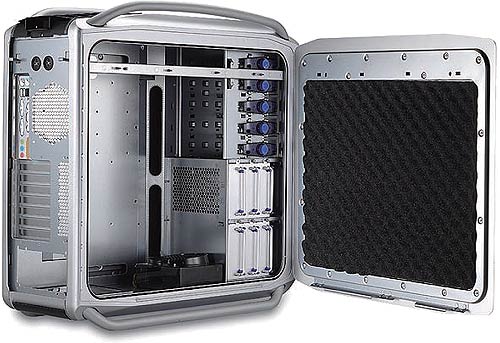
Quiet Features
As you can see from the above image each side panel is lined with acoustic material. This material is designed to reduce airborne noise which helps to make the system run quieter. It also give the side panels a more sturdy feel.
The Cosmos can accommodate up to six hard drives and each one is installed in a hard drive cage; and to help reduce vibrations each hard drive is mounted with rubber grommets.
Using the right CPU and VGA cooler along with the included acoustic material, rubber grommets for the hard drives and the quiet 120mm fans will ensure your system is running cool and quiet.
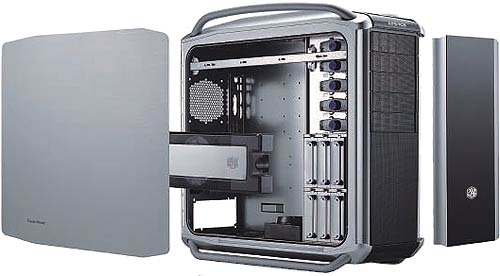
Other Features
Opening the side panels on the Cosmos is a joy to behold! At the rear of the case is a latch and once pressed the side panel is released. This make accessing the internals of the case very simple indeed. Fit the side panel back in place is just as easy. Just line it up and firmly press it in!
When you open the side panel for the first time you will notice a large plastic air duct that stretches from the rear of the case to the hard drives. This air duct is designed to direct the airflow over the graphics cards where it is expelled through a grille on the rear of the case. If the air duct is not required then it can be easily removed.
Opening the door at the front of the case reveals five 5¼” drive bays. The bottom drive bay can also accommodate a 3½” device. One feature that shows that Coolermaster have designed a great case is the fact that you can unhinge the front door and re-hinge it at the other side. This means you are able to open the door from either side of the case.
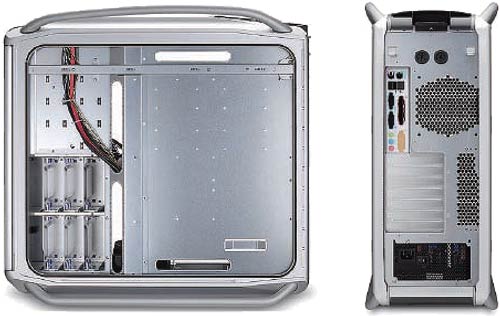
Features
- Soundproof materials applied to build a quiet environment
- Sound barrier design reduces vibration for silent operation
- Dual bottom air intakes to enhance air flow and reduce system noise
- Six aluminium detachable HDD modules with ventilation holes for optimising cooling
- Side removable VGA cooling tunnel to advance thermal airflow
- Tool-free design for opening side panel conveniently
- Cable management system for better cable routing and neatness
| Specifications | Cosmos 1000 |
|---|---|
| Dimensions | (W) 266 x (H) 598 x (D)628 mm |
| Net Weight | 16.9 kg |
| Material Chassis | Steel |
| Motherboards | Extended ATX, ATX |
| 5.25” Drive Bay | Five Exposed (without the use of exposed 3.5 inch drive bay) |
| 3.5” Drive Bay | Six (Hidden), one Exposed (converted from one 5.25 inch drive bay) |
| I/O Panel | USB 2.0 x 4, IEEE 1394 x 1, Audio x 1, SPK x 1, eSATA x 1 (Supports HD Audio) |
| Cooling System | Bottom fan (intake) 120x120x25 mm x 1, 1200 rpm, 17 dBA (supplied), Top fan (exhaust) : 120x120x25 mm fan x 2, 1200 rpm, 17 dBA (supplied), Rear fan (exhaust) : 120x120x25 mm x 1 (supplied) |
| Expansion Slots | Seven |
| Power Supply | Standard ATX |
| Other | Tool Box |
| Specifications | Cosmos 1000 |
|---|---|
| Dimensions | (W) 266 x (H) 598 x (D)628 mm |
| Net Weight | 16.9 kg |
| Material Chassis | Steel |
| Motherboards | Extended ATX, ATX |
| 5.25” Drive Bay | Five Exposed (without the use of exposed 3.5 inch drive bay) |
| 3.5” Drive Bay | Six (Hidden), one Exposed (converted from one 5.25 inch drive bay) |
| I/O Panel | USB 2.0 x 4, IEEE 1394 x 1, Audio x 1, SPK x 1, eSATA x 1 (Supports HD Audio) |
| Cooling System | Bottom fan (intake) 120x120x25 mm x 1, 1200 rpm, 17 dBA (supplied), Top fan (exhaust) : 120x120x25 mm fan x 2, 1200 rpm, 17 dBA (supplied), Rear fan (exhaust) : 120x120x25 mm x 1 (supplied) |
| Expansion Slots | Seven |
| Power Supply | Standard ATX |
| Other | Tool Box |
FAQ
Do high wattage power supplies cost more to run?
No - the rated wattage of a power supply refers to the maximum amount of power it can deliver at full load, not how much power it uses. More powerful PSUs will consume around the same amount of power as lower powered power supplies in any given PC system, so your electricity bill will not be higher when using a more powerful power supply!
The best way to reduce your electricity bill when using your PC is to use a more efficient power supply or make your PC consume less power by removing components which are not needed, such as extra drives and expansion cards, or by choosing a cooler-running processor or graphics card.
My brand new power supply doesn’t work! Am I doing something wrong?
It’s possible that the power supply may be faulty, but here are some simple things to check. Firstly, a power supply will not work if you simply plug it in and flick the switch. The power supply will only turn on if you connect it to a working motherboard and associated items (processor, memory, video card, etc). It is actually the motherboard which tells the power supply when to switch on.
Secondly (if applicable), check the voltage is set correctly to 115/230 volts depending on what country you are in. Thirdly, if possible it would be good to try the power supply in another PC to see if it works, or try another power supply in your PC to see if that works. You can then tell whether it is the power supply which is faulty or the actual PC itself. If all else fails, please contact us for further support, and/or return details.
Why should I buy a whole new PSU when I could just replace the noisy fan in my existing one?
Virtually all the noise generated by a PC power supply originates from the cooling fan inside it, so simply replacing the fan with a quiet fan may seem an obvious way to go. However, if you are thinking about attempting this operation, please bear the following points in mind:
- Your existing power supply will be designed to run with a specific amount of airflow in order to adequately cool the components inside and reducing the airflow may lead to overheating and damage to the power supply and/or PC.
- All PC power supplies contain very high voltages and even with the power disconnected, the voltages stored in the capacitors can be easily enough to kill. It is not recommended to take the cover off any PC power supply for this reason unless you are absolutely confident of your own ability. Because of the grave dangers involved, all PC power supplies by law carry a warning label forbidding removal of the power supply case.
- There will be no standard PC fan connector inside the power supply to use to connect a replacement fan, and it would probably have to be soldered directly into the PCB inside the power supply, or have a specialist power connector attached. This can be a tricky operation to say the least.
Please consider the above points very carefully before proceeding with an operation to replace the fan in your existing power supply!
What is PFC (Power Factor Correction)?
If you are interested in being “green” and saving the planet, you might like to read a short explanation of how our power supplies can save energy using Active PFC (Power Factor Correction), not to be confused with Power Conversion Efficiency which is also very good in most of our PSUs. “Power Factor” is a measure of how efficiently electrical power is consumed. Ideally, Power Factor would be 1 (or 100%) and known as unity.
Unfortunately in the real world, Power Factor is reduced by highly inductive loads down to values of 0.7 (70%) or less. This induction is caused by equipment such as small electric motors, fans, fluorescent lighting ballasts and transformers such as those in PSUs. This is bad news for the electricity generating companies who can impose a surcharge on heavy users if they have a consistently low Power Factor, as more electricity has to be produced to make up the shortfall.
Power Factor Correction (PFC) is used in some equipment to minimise the inductive component of the electrical current. This helps to reduce the losses in the electrical supply to that equipment. Power Factor Correction capacitors are normally used to reduce induction in an electrical load, which minimises wasted energy and hence improves the efficiency of a company and reduces electricity costs.
It is not usually practical to reach unity, i.e. Power Factor 1, and it seems that most electricity supply companies accept consumers having a Power Factor as low as 0.94 (94%) without imposing a surcharge. Unfortunately most of the cheap (and not so cheerful) PSUs tend to have a Passive PF as low as 0.75 or 75% which in a large office can lead to a PF surcharge.
However, the good news is that most of Quiet PC’s PSUs implement a system known as Active PFC which involves some clever electronics. This means that their power factor (PF) can be as high as 0.94 or 94% (at full load), while harmful harmonic frequencies are reduced to well below legal requirements. So by using our products, you can be happy in the knowledge that you are doing your bit to save the planet!
How do I know what size of wattage power supply I need?
The best answer we can give to this question is to go ahead and take an intelligent “guesstimate”! There are no hard and fast rules about what size of power supply any given PC needs as a minimum. Our advice would be that if you are replacing an existing power supply, then consider a new one at least of the same wattage as the old one. In addition, if you wish to build in a “safety margin” to allow for reliable running and possible future upgrades, consider adding 100-200 watts to the rating of your existing unit.
If you are building a new PC, most customers now buy a power supply rated in the region of 500-800 watts depending primarily on the performance level of their graphics card(s) and number of drives to be installed. But in any event if you are unsure about which power supply would be best for your PC then please do contact us by phone or email and we will be happy to give you a specific recommendation based on your budget.
My new PSU came with a 24-pin connector but my motherboard needs 20 pins! Do I need an adaptor cable?
We receive many customer enquiries about this. In fact, most of the 24-pin compatible power supplies we sell come with special motherboard connectors which can be converted to 20-pins with no additional conversion cables. All you need to do is look carefully at the connector and you will see that the end four pins can be slid off, turning the connector into a 20-pin compatible one (see below) - easy when you know how!
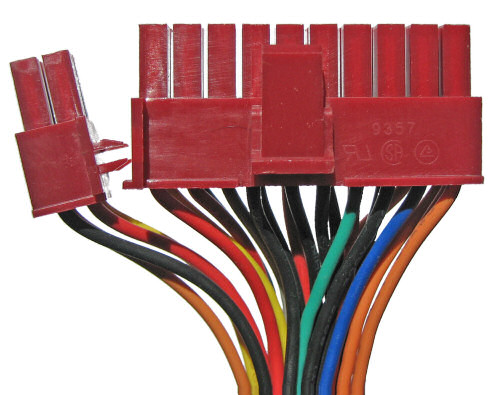
Image showing how to change a power supply’s 24-pin motherboard connector into a 20-pin connector by unclipping the end four-pin blockWhat do the PSU safety protection abbreviations mean?
There are many possible safety protections a PSU can have. Below is a list of what each abbreviation means. Please note, not all PSUs have all safety protections.
- OCP - Over-Current Protection
- OVP - Over Voltage Protection
- UVP - Under Voltage Protection
- SCP - Short Circuit Protection
- OPP - Over Power Protection
- OTP - Over Temperature Protection
- UL - Underwriters Laboratories, more information.
- TÜV - Technical Inspection Association, more information.
- CE - European Conformity, more information.
- FCC - Federal Communications Commission, more information.
- RoHS - Restriction of Hazardous Substances Directive, more information.
- WEE - Electronic waste, more information.
- 80 PLUS - Promotes energy efficiency for PC power supplies, more information.
- ErP - Energy Related Products, more information.
More information on certification marks can be found here.
Top Quiet PC Cases

Streacom FC8WS ALPHA Black Fanless Aluminium ITX Chassis, no optical

Streacom ST-BC1 V2 Silver Aluminium ATX Open Benchtable
Akasa Galileo TU3 Plus MKII 1U Rackmount Fanless Thin Mini-ITX Case

Fractal Design Define 7 Compact Black Mid Tower PC Case

Streacom FC8WS ALPHA Silver Fanless Aluminium ITX Chassis, no optical
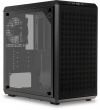
Cooler Master Masterbox Q300L V2 Micro-ATX PC Chassis

Antec P5-SILENT, Quiet Mid-Tower Micro-ATX PC Chassis

Streacom FC8WS ALPHA Titanium Fanless Aluminium ITX Chassis, no optical
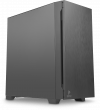
Antec P10C Thermal Performance ATX Case with Sound Dampening Foam

Streacom ST-BC1 V2 Titanium Aluminium ATX Open Benchtable

